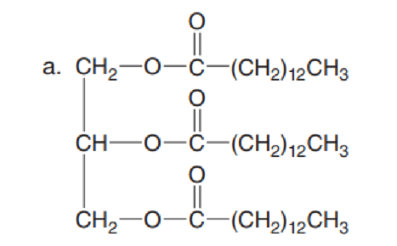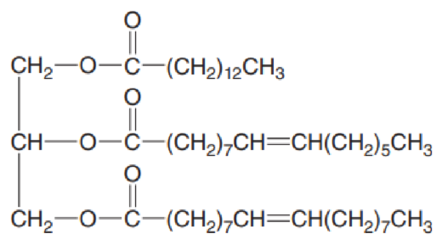
Principles of General, Organic, Biological Chemistry
2nd Edition
ISBN: 9780073511191
Author: Janice Gorzynski Smith Dr.
Publisher: McGraw-Hill Education
expand_more
expand_more
format_list_bulleted
Concept explainers
Textbook Question
Chapter 15.5, Problem 15.11P
Draw the products formed from hydrolysis of each triacylglycerol.
- a.

- b.

Expert Solution & Answer
Want to see the full answer?
Check out a sample textbook solution
Students have asked these similar questions
How to draw the reaction mechasnism below
Name the following molecules with IUpac
What is the molecular orbital for cyclopropenyl anion and is it aromatic, antiaromatic or nonaromatic?
Chapter 15 Solutions
Principles of General, Organic, Biological Chemistry
Ch. 15.1 - In which solvents or solutions will a lipid be...Ch. 15.2 - (a) Draw a skeletal structure for each fatty acid....Ch. 15.2 - Prob. 15.3PCh. 15.2 - Prob. 15.4PCh. 15.3 - Draw the structure of a wax formed from stearic...Ch. 15.3 - One component of jojoba oil is a wax formed from...Ch. 15.3 - What hydrolysis products are formed when cetyl...Ch. 15.4 - Draw the structure of a triacylglycerol that...Ch. 15.4 - Prob. 15.9PCh. 15.4 - Draw the structure of a triacylglycerol that fits...
Ch. 15.5 - Draw the products formed from hydrolysis of each...Ch. 15.5 - Prob. 15.12PCh. 15.6 - Draw the structure of two different cephalins...Ch. 15.6 - Classify each lipid as a triacylglycerol,...Ch. 15.7 - Why are phospholipids rather than triacylglycerols...Ch. 15.7 - Prob. 15.16PCh. 15.8 - Prob. 15.17PCh. 15.8 - Prob. 15.18PCh. 15.9 - Prob. 15.19PCh. 15.9 - Prob. 15.20PCh. 15.10 - Why is it much easier to overdose on a fat-soluble...Ch. 15.10 - Prob. 15.22PCh. 15 - Prob. 15.23UKCCh. 15 - Prob. 15.24UKCCh. 15 - Prob. 15.25UKCCh. 15 - What hydrolysis products are formed when the wax...Ch. 15 - Prob. 15.27UKCCh. 15 - Prob. 15.28UKCCh. 15 - Draw the products formed when the given...Ch. 15 - Prob. 15.30UKCCh. 15 - Prob. 15.31UKCCh. 15 - Prob. 15.32UKCCh. 15 - Prob. 15.33APCh. 15 - Label each compound as a hydrolyzable or...Ch. 15 - Prob. 15.35APCh. 15 - Prob. 15.36APCh. 15 - Prob. 15.37APCh. 15 - How does each of the following affect the melting...Ch. 15 - Rank the fatty acids in order of increasing...Ch. 15 - How would you expect the melting points of the...Ch. 15 - Prob. 15.41APCh. 15 - Why are soaps water soluble, but the fatty acids...Ch. 15 - Draw the structure of a wax formed from palmitic...Ch. 15 - Prob. 15.44APCh. 15 - Prob. 15.45APCh. 15 - Prob. 15.46APCh. 15 - Prob. 15.47APCh. 15 - What hydrolysis products are formed when each wax...Ch. 15 - Draw a triacylglycerol that fits each description:...Ch. 15 - Draw a triacylglycerol that fits each description:...Ch. 15 - Prob. 15.51APCh. 15 - Prob. 15.52APCh. 15 - Prob. 15.53APCh. 15 - Prob. 15.54APCh. 15 - Prob. 15.55APCh. 15 - Draw the products formed when the given...Ch. 15 - Prob. 15.57APCh. 15 - Prob. 15.58APCh. 15 - Prob. 15.59APCh. 15 - Prob. 15.60APCh. 15 - Prob. 15.61APCh. 15 - Why are LDLs soluble in the blood?Ch. 15 - Describe the role of HDLs and LDLs in cholesterol...Ch. 15 - Prob. 15.64APCh. 15 - Prob. 15.65APCh. 15 - Prob. 15.66APCh. 15 - Answer each question with regards to vitamins A...Ch. 15 - Answer each question in Problem 15.67 for vitamins...Ch. 15 - Prob. 15.69APCh. 15 - Prob. 15.70APCh. 15 - Prob. 15.71APCh. 15 - How are soaps and phosphoacylglycerols similar in...Ch. 15 - Some fish oils contain triacylglycerols formed...Ch. 15 - Some marine plankton contain triacylglycerols...Ch. 15 - Prob. 15.75APCh. 15 - Prob. 15.76APCh. 15 - Prob. 15.77APCh. 15 - Prob. 15.78APCh. 15 - Prob. 15.79CPCh. 15 - Prob. 15.80CP
Knowledge Booster
Learn more about
Need a deep-dive on the concept behind this application? Look no further. Learn more about this topic, chemistry and related others by exploring similar questions and additional content below.Similar questions
- Using the chart describe the change from cystine to tyrosine and its impact on the protein. Using the chart describe the change from histidine to aspartic acid and its impact on the protein.arrow_forwardHow to get the predicted product of this reaction belowarrow_forwardPlease help me fill out the chart then using the chart describe the change from cystine to tyrosine and its impact on the protein. Then using the chart describe the change from histidine to aspartic acid.arrow_forward
arrow_back_ios
SEE MORE QUESTIONS
arrow_forward_ios
Recommended textbooks for you
 Chemistry for Today: General, Organic, and Bioche...ChemistryISBN:9781305960060Author:Spencer L. Seager, Michael R. Slabaugh, Maren S. HansenPublisher:Cengage Learning
Chemistry for Today: General, Organic, and Bioche...ChemistryISBN:9781305960060Author:Spencer L. Seager, Michael R. Slabaugh, Maren S. HansenPublisher:Cengage Learning Introduction to General, Organic and BiochemistryChemistryISBN:9781285869759Author:Frederick A. Bettelheim, William H. Brown, Mary K. Campbell, Shawn O. Farrell, Omar TorresPublisher:Cengage Learning
Introduction to General, Organic and BiochemistryChemistryISBN:9781285869759Author:Frederick A. Bettelheim, William H. Brown, Mary K. Campbell, Shawn O. Farrell, Omar TorresPublisher:Cengage Learning
 Chemistry: Matter and ChangeChemistryISBN:9780078746376Author:Dinah Zike, Laurel Dingrando, Nicholas Hainen, Cheryl WistromPublisher:Glencoe/McGraw-Hill School Pub Co
Chemistry: Matter and ChangeChemistryISBN:9780078746376Author:Dinah Zike, Laurel Dingrando, Nicholas Hainen, Cheryl WistromPublisher:Glencoe/McGraw-Hill School Pub Co

Chemistry for Today: General, Organic, and Bioche...
Chemistry
ISBN:9781305960060
Author:Spencer L. Seager, Michael R. Slabaugh, Maren S. Hansen
Publisher:Cengage Learning


Introduction to General, Organic and Biochemistry
Chemistry
ISBN:9781285869759
Author:Frederick A. Bettelheim, William H. Brown, Mary K. Campbell, Shawn O. Farrell, Omar Torres
Publisher:Cengage Learning



Chemistry: Matter and Change
Chemistry
ISBN:9780078746376
Author:Dinah Zike, Laurel Dingrando, Nicholas Hainen, Cheryl Wistrom
Publisher:Glencoe/McGraw-Hill School Pub Co
Lipids - Fatty Acids, Triglycerides, Phospholipids, Terpenes, Waxes, Eicosanoids; Author: The Organic Chemistry Tutor;https://www.youtube.com/watch?v=7dmoH5dAvpY;License: Standard YouTube License, CC-BY